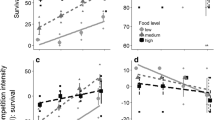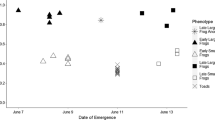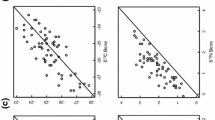Abstract
Phenotype is often correlated with resource use, which suggests that as phenotypic variation in a population increases, intraspecific competition will decrease. However, few studies have experimentally tested the prediction that increased intraspecific phenotypic variation leads to reduced competitive effects (e.g., on growth rate, survival or reproductive rate). We investigated this prediction with two experiments on wood frogs (Rana sylvatica). In the first experiment, we found that a frog’s size was positively correlated with the size of its preferred prey, indicating that the feeding niche of the frogs changed with size. In the second experiment, we used an experimental design in which we held the initial mass of “focal” frogs constant, but varied the initial mass of their competitors. We found a significant quadratic effect of the average mass of competitors: focal frog growth was lowest when raised with similar-sized competitors, and highest when raised with competitors that were larger or smaller. Our results demonstrate that growth rates increase (i.e., competitive intensity decreases) when individuals are less similar to other members of the population and exhibit less overlap in resource use. Thus, changes in the amount of phenotypic variation in a population may ultimately affect population-level processes, such as population growth rate and extinction risk.


Similar content being viewed by others
References
Altwegg R (2003) Multistage density dependence in an amphibian. Oecologia 136:46–50. doi:10.1007/s00442-003-1248-x
Altwegg R, Reyer HU (2003) Patterns of natural selection on size at metamorphosis in water frogs. Evolution 57:872–882. doi:10.1111/j.0014-3820.2003.tb00298.x
Bardsley L, Beebee TJC (2001) Non-behavioral interference competition between anuran larvae under semi-natural conditions. Oecologia 128:360–367
Berven KA (1987) The heritable basis of variation in larval developmental patterns within populations of the wood frog (Rana sylvatica). Evolution 41:1088–1097
Berven KA (1990) Factors affecting population fluctuations in larval and adult stages of the wood frog (Rana sylvatica). Ecology 71:1599–1608. doi:10.2307/1938295
Berven KA (2009) Density dependence in the terrestrial stage of wood frogs: evidence from a 21-year population study. Copeia 328–338. doi: 10.1643/Ch-08-052
Bolker B, Holyoak M, Krivan V, Rowe L, Schmitz O (2003) Connecting theoretical and empirical studies of trait-mediated interactions. Ecology 84:1101–1114. doi:10.1890/0012-9658(2003)084[1101:CTAESO]2.0.CO;2
Bolnick DI (2004) Can intraspecific competition drive disruptive selection? An experimental test in natural populations of sticklebacks. Evolution 58:608–618. doi:10.1111/j.0014-3820.2004.tb01683.x
Bolnick DI et al (2003) The ecology of individuals: incidence and implications of individual specialization. Am Nat 161:1–28. doi:10.1086/343878
Chelgren ND, Rosenberg DK, Heppell SS, Gitelman AI (2006) Carryover aquatic effects on survival of metamorphic frogs during pond emigration. Ecol Appl 16:250–261. doi:10.1890/04-0329
Christian KA (1982) Changes in the food niche during post-metamorphic ontogeny of the frog Pseudacris triseriata. Copeia 73–80. doi:10.2307/1444270
Crutsinger GM, Reynolds WN, Classen AT, Sanders NJ (2008) Disparate effects of plant genotypic diversity on foliage and litter arthropod communities. Oecologia 158:65–75. doi:10.1007/s00442-008-1130-y
De Roos AM, Persson L, McCauley E (2003) The influence of size-dependent life-history traits on the structure and dynamics of populations and communities. Ecol Lett 6:473–487. doi:10.1046/j.1461-0248.2003.00458.x
Ducey PK (1989) Agonistic behavior and biting during intraspecific encounters in Ambystoma salamanders. Herpetologica 45:155–160
Einum S, Fleming IA (2004) Does within-population variation in egg size reduce intraspecific competition in Atlantic Salmon, Salmo salar? Funct Ecol 18:110–115. doi:10.1111/j.1365-2435.2004.00824.x
Flowers MA, Graves BM (1995) Prey selectivity and size-specific diet changes in Bufo cognatus and B. woodhousii during early postmetamorphic ontogeny. J Herpetology 29:608–612
Gamfeldt L, Källström B (2007) Increasing intraspecific diversity increases predictability in population survival in the face of perturbations. Oikos 116:700–705. doi:10.1111/j.2007.0030-1299.15382.x
Harper EB, Semlitsch RD (2007) Density dependence in the terrestrial life history stage of two anurans. Oecologia 153:879–889. doi:10.1007/s00442-007-0796-x
Hirai T (2002) Ontogenetic change in the diet of the pond frog, Rana nigromaculata. Ecol Res 17:639–644. doi:10.1046/j.1440-1703.2002.00521.x
Hughes AR, Stachowicz JJ (2004) Genetic diversity enhances the resistance of a seagrass ecosystem to disturbance. Proc Natl Acad Sci USA 101:8998–9002. doi:10.1073/pnas.0402642101
Hughes AR, Inouye BD, Johnson MTJ, Underwood N, Vellend M (2008) Ecological consequences of genetic diversity. Ecol Lett 11:609–623. doi:10.1111/j.1461-0248.2008.01179.x
Johnson MTJ, Lajeunesse MJ, Agrawal AA (2006) Additive and interactive effects of plant genotypic diversity on arthropod communities and plant fitness. Ecol Lett 9:24–34. doi:10.1111/j.1461-0248.2005.00833.x
Lima AP (1998) The effects of size on the diets of six sympatric species of postmetamorphic litter anurans in central Amazonia. J Herpetol 32:392–399
Newman RA (1999) Body size and diet of recently metamorphosed spadefoot toads (Scaphiopus couchii). Herpetologica 55:507–515
Newman RA, Dunham AE (1994) Size at metamorphosis and water loss in a desert anuran (Scaphiopus couchii). Copeia 372–381. doi:10.2307/1446984
Ovadia O, Dohna HZ, Booth G, Schmitz OJ (2007) Consequences of body size variation among herbivores on the strength of plant–herbivore interactions in a seasonal environment. Ecol Model 206:119–130. doi:10.1016/j.ecolmodel.2007.03.022
Peacor SD, Pfister CA (2006) Experimental and model analyses of the effects of competition on individual size variation in wood frog (Rana sylvatica) tadpoles. J Anim Ecol 75:990–999. doi:10.1111/j.1365-2656.2006.01119.x
Peacor SD, Schiesari L, Werner EE (2007) Mechanisms of nonlethal predator effect on cohort size variation: ecological and evolutionary implications. Ecology 88:1536–1547. doi:10.1890/06-1066
Quevedo M, Svanback R, Eklov P (2009) Intrapopulation niche partitioning in a generalist predator limits food web connectivity. Ecology 90:2263–2274. doi:10.1890/07-1580.1
Scott DE (1994) The effect of larval density on adult demographic traits in Ambystoma opacum. Ecology 75:1383–1396. doi:10.2307/1937462
Semlitsch RD, Scott DE, Pechmann JHK (1988) Time and size at metamorphosis related to adult fitnss in Ambystoma talpoideum. Ecology 69:184–192. doi:10.2307/1943173
Smith DC (1987) Adult recruitment in chorus frogs: effects of size and date at metamorphosis. Ecology 68:344–350. doi:10.2307/1939265
Smyers SD, Rubbo MJ, Townsend VR, Swart CC (2002) Intra- and interspecific characterizations of burrow use and defense by juvenile ambystomatid salamanders. Herpetologica 58:422–429
Sommer S, Pearman PB (2003) Quantitative genetic analysis of larval life history traits in two alpine populations of Rana temporaria. Genetica 118:1–10. doi:10.1023/A:1022965424352
Uchmański J (2000) Individual variability and population regulation: an individual-based model. Oikos 90:539–548. doi:10.1034/j.1600-0706.2000.900312.x
Vonesh JR, Warkentin KM (2006) Opposite shifts in size at metamorphosis in response to larval and metamorph predators. Ecology 87:556–562. doi:10.1890/05-0930
Werner EE, Peacor SD (2003) A review of trait-mediated indirect interactions in ecological communities. Ecology 84:1083–1100. doi:10.1890/0012-9658(2003)084[1083:AROTII]2.0.CO;2
Acknowledgments
This work was conducted on the University of Michigan’s E.S. George Reserve. We thank Leslie Cabrera, Brian Duchemin, and Sam Upton for logistical assistance with this experiment. Earl Werner, the Werner lab group and two anonymous reviewers provided valuable feedback on our manuscript. M.F.B. was supported in part by the Michigan Society of Fellows at the University of Michigan. J.M.M. was supported by the Edwin S. George Reserve Scholarship and the Helen Olsen Brower Memorial Fellowship at the University of Michigan. This work complies with the current laws of the United States of America.
Conflict of interest
We declare that we have no conflict of interest.
Author information
Authors and Affiliations
Corresponding author
Additional information
Communicated by Anssi Laurila.
Rights and permissions
About this article
Cite this article
Benard, M.F., Middlemis Maher, J. Consequences of intraspecific niche variation: phenotypic similarity increases competition among recently metamorphosed frogs. Oecologia 166, 585–592 (2011). https://doi.org/10.1007/s00442-010-1896-6
Received:
Accepted:
Published:
Issue Date:
DOI: https://doi.org/10.1007/s00442-010-1896-6




